Beating Your Competition With Better Mobile Customer Support
Smartphones have become so ubiquitous that it’s difficult to remember a time when this wasn’t the case. Smartphone ownership among adults in the U.S. nearly doubled in the four years leading up to 2015.
Growth of Smartphone Ownership Among US Adults
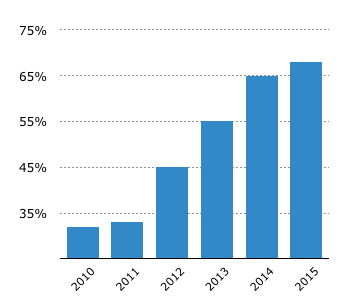
Source: Pew Research Center Technology Device Ownership: 2015
And, despite what the media is telling you, we aren’t all using them to play Pokémon Go.
Instead, we’re using them to post to social media, to research products and to look for answers to our customer support questions.
In fact, just last year Google announced that in the U.S. (and nine other countries) a majority of internet searches are performed on mobile devices.
If you think this major cultural shift isn’t impacting your business, then it’s time to rethink. Now, more than ever, consumers make purchase and loyalty decisions based on the quality of their mobile experiences.
If you aren’t beating your competition with better mobile support, then chances are they’re the ones beating you.
In this report, we look at two important mobile support technologies and the results they can bring, including:
Virtual Agents to Guide Mobile Navigation
Advanced Analytics for Personalized Service
Virtual Agents to Guide Mobile Navigation
Have you seen Pokémon Go players bumbling and bumping along, trying to navigate the real world through a smartphone screen? They provide the perfect metaphor for the experience many customers have when they try to navigate the online world in search of customer support information.
Last year we surveyed U.S. consumers about their customer service preferences and habits. We learned that when consumers have service questions they need answered, 73 percent look for an answer online first. This means:
When customers with service questions contact your company by phone, email or support ticket, a majority have already tried (and possibly failed) to find the answer online.
Clearly, it would be better for everyone involved if the customer had found the answer online. The customer would have saved time and effort, increasing their loyalty, and your company would have saved the costs associated with providing human support.
When it comes to customers using mobile devices, we have a pretty clear picture of the problems they encounter with their online searches.
What Keeps Mobile Customers
From Finding Service Answers Online
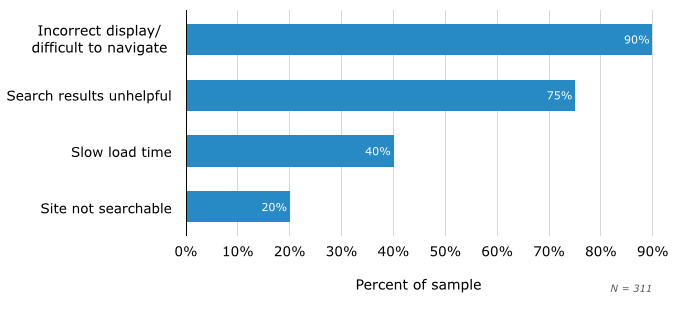
The hard truth is: No matter how well a company designs their online service resources, no matter how well organized and arranged they are, some customers—especially mobile customers—will not find them quickly or easily enough.
Virtual agent technology is one of the most cost-effective solutions to this needle-in-a-haystack scenario.
From the customer’s perspective, a virtual agent appears on a website as either a chat-style pop-up window, or, more commonly, as an “Enter your question here” box (see the example in the screenshot below).
The software analyzes the customer’s question and offers possible solutions in the form of relevant articles, FAQ pages, videos or any other instructional resource. Most importantly, it helps the customer navigate directly to the solution, ensuring they don’t encounter any of the issues listed above.
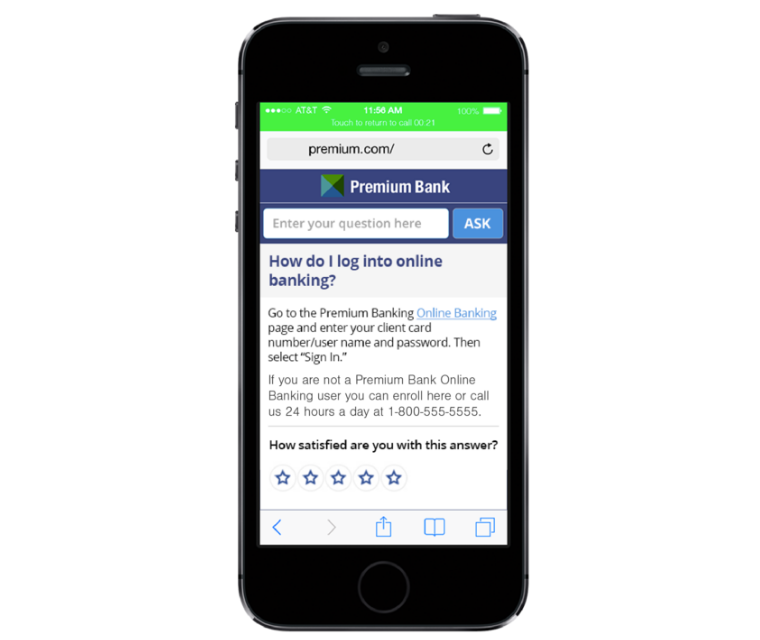

The IntelliResponse Virtual Agent offers mobile customers an intuitive interface, helping them find the right answer before giving up
Virtual agent (VA) software varies from vendor to vendor. Buyers should consider the following questions when researching specific solutions:
Is this VA a standalone tool, or is it part of a larger customer service platform?
How customizable is the look and feel of the VA? Will it seem out of place on our site?
Can the back end of the software provide reports or analysis of how customers are using the VA?
How do we populate the VA’s back end with our knowledge resources?
Can we select which website visitors see the VA option, based on the device they’re using?
The magic of VAs comes from their ability to parse human language into bits of information from which the software can identify meaning and intent. The analytical rules used to do this are where the “intelligence” of the VA lies and lead to our second suggestion for improving mobile support.
Advanced Analytics for Personalized Service
If a mobile customer has visited your website in the past, he or she will probably remember having visited it. But what about the website itself—Will it know if a customer is returning for the second time and offer different information, or does it display the same information to all visitors?
Customer service platforms with advanced analytics tools are becoming increasingly integrated with online and digital properties. A decade ago, a company’s website and its customer service software were two entirely separate entities. Nowadays, as more service software vendors add tools to improve and automate online service, the line between them is increasingly blurred.
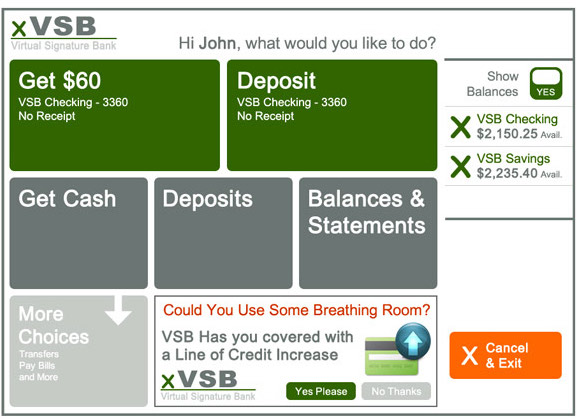

A landing page tailored to a banking customer’s recent activity with Infor Epiphany
Embedded analytics is the term for analytical processes that are built into business process platforms such as those used for customer relationship management (CRM) and customer service. (We have a great in-depth discussion of embedded analytics here.)
There are many advantages to embedding analytical processes into customer-facing platforms. Of most interest to us here is the fact that they can greatly improve a customer’s mobile support experience.
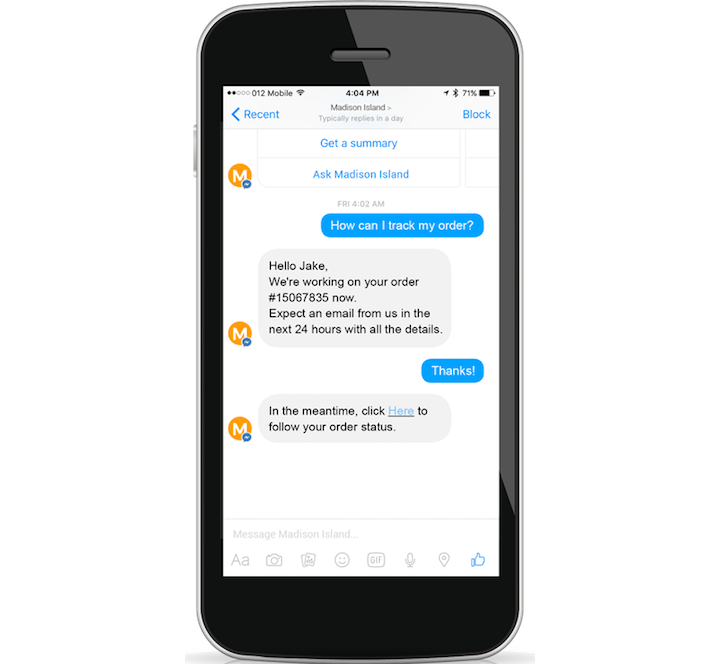

Example customer interaction using NanoRep virtual assistant technology
In the image above, we see how embedded analytics improves the customer’s mobile experience, saving them time and hassle. Not only can the back-end analytics understand the customer’s question—”How can I track my order?”— it also understands the intent behind the question.
This is an important distinction. The specific question a customer asks, and their reason for asking it, are not always identical.
In the example above, the customer wants to actually track their order, not just understand how it could be done. So the NanoRep software gives an answer that addresses the intent of the question, saving the customer from having to ask follow-up questions, and reducing the chances they’ll encounter any of the problems common to mobile browsing.
Good virtual agent software is able to differentiate between a question’s literal meaning and the intent behind it. Here are a few more examples:
Examples of How Advanced Analytics Identifies Customer Intent
The customer’s actual question: | The simplest, most direct answer: | The ‘intent’ that the simple answer missed: | An answer that addresses both the question and the intent behind it: |
How late is your store open on Fridays? | We’re open until 8pm on Fridays. | The customer is planning to visit the store this Friday. Will the store be open that day? | We’re open until 8pm on most Fridays, but this Friday we’ll be closing at 6pm. |
How long after a purchase can I return an item? | You have 90 days to return an item. | The customer has an item they want to return. How does the return process work? | You have 90 days to return an item. Are you looking to return the item you bought on (specific date)? |
Is this case compatible with my (brand/model) cellphone? | No, this case is for an older model. | The customer wants to buy a case for their cell phone. Which cases are compatible? | No, this case is for an older model. Here are some cases that are compatible with your phone (links to products). |
Advanced analytics tools are also opening the doors to new levels of personalized customer service. By tracking which customers request service when and for what reasons, these tools build up a wealth of data. That data can be mined for common patterns that are used to fine tune service offerings.
Example scenarios include:
An analytics platform shows a company how one of its many knowledgebase articles is extremely helpful, but seemingly only for desktop users. A closer look reveals that the HTML formatting of the article makes it display poorly on mobile devices. Fixing the formatting makes the article accessible to all users, mobile included, thereby leveraging the value of the article to assist more customers.
An e-commerce company sells accessories for smartphones. They have many thousands for sale, and customers spend a lot of time browsing the website. To save customers time, a virtual agent is added to the website. It determines whether a visitor is using an Android or Apple device, then offers to filter out all incompatible products.
Conclusions
Anticipating customer questions and answering them before they’re even asked is a hallmark of excellent customer service. Equally important is knowing from which type of device customers most commonly seek answers. And, as the data above suggests, we already know the answer to that:
Most consumers are searching for answers online, and a majority do so on a mobile device.
Virtual agents and service platforms with built-in analytical tools are two highly effective solutions for improving mobile support experiences. They save consumers time and frustration and save the companies that use them attrition costs and costs associated with providing live tier-one customer support.
For more information on virtual agents or customer service platforms, check out our Buyer’s Guide and user reviews here. If you’re ready for a shortlist of products that will meet your specific needs, then call (855) 998-8505 for a free Fast Consultation.